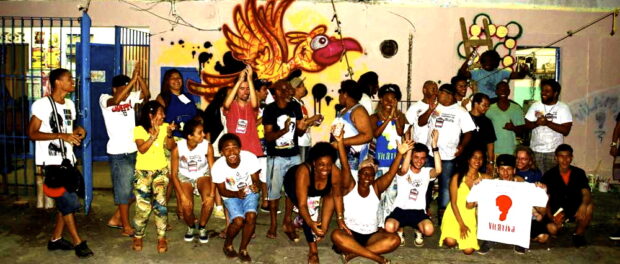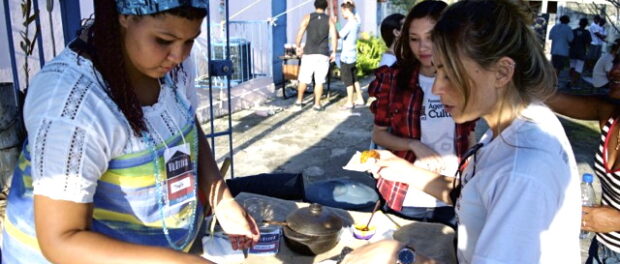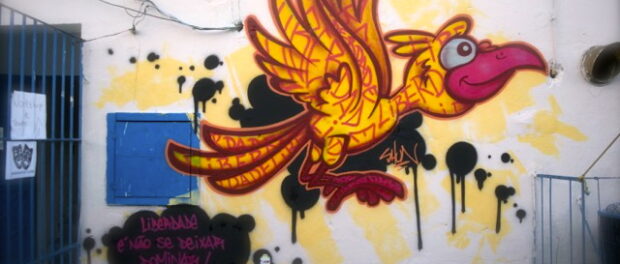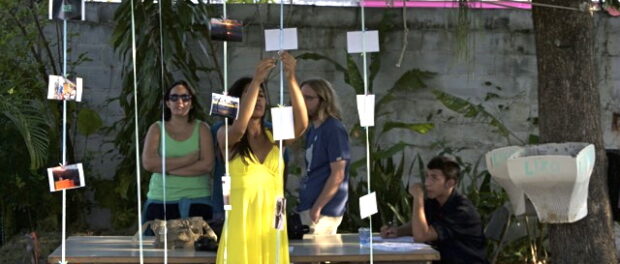
On Saturday December 6 residents of the Vila Kennedy community hosted the VilAtiva cultural encounter, a diverse exhibition of artistic endeavors and community initiatives organized by the young members of the VilAtiva Collective.
From 4PM until just before midnight, the Quafa Neighborhood Association–a community within Vila Kennedy–hosted a multitude of cultural activities organized by members of the collective.
Graffiti artists adorned the walls of the building with colorful murals as local musicians played under a tarp and a VilAtiva member dressed in traditional Baiana clothing handed out free samples of northeastern Brazilian cuisine. Within the building, stylists from a local salon offered haircuts and makeovers while a professional actor led a theater arts workshop for young people.
As the crowd grew, local DJs started playing music and a dance contest ensued. Later that night, a live band supplied beats for a rap battle among local and guest MCs. Several other guest participants put up a photography exhibit and a table covered with books to trade with community residents.
The event, which brought together a wide range of Vila Kennedy residents of all ages, developed as a project of the Favela Criativa (or Creative Favela) program.
The 20 members of the VilAtiva Collective are involved in this initiative, which seeks to educate and empower young artists and cultural creators in 20 different pacified favelas across Rio de Janeiro. Vila Kennedy, which received a Pacifying Police Unit (UPP) last March, is among the most recently pacified communities in Rio.
Favela Criativa, which was established as a partnership between the Rio de Janeiro’s Secretariat of Culture and other public institutions as well as private investors, puts together several projects meant to create windows of opportunity for favela youth. It states its mission as “strengthening, promoting and giving visibility to the cultural production of the state’s favelas.” The courses and workshops it offers are defined in terms of its three principal educational tenets: creative management, artistic training, and resource procurement for cultural initiatives. Beyond just gaining these skills, course participants are expected to put on a cultural project of their own.
In the case of the Vila Kennedy residents who organized the cultural intervention, the Favela Criativa program, had taken a six-month course in all these three areas. The event on Saturday was a way to showcase their newly-learned skills.
While the VilAtiva event was linked to the Favela Criativa program in Vila Kennedy, it also stood on its own as a community-oriented spectacle designed to get other residents interested in the latent cultural potential of their neighborhood.
Vinicius Souza, a Favela Criativa participant and one of the event’s organizers, mentioned that this event would hopefully be “the first in a series of cultural interventions” in his community and in the West Zone in general. While grateful for the new possibilities opened up through the Favela Criativa initiative, the Vila Kennedy resident and journalism student said: “Ideally, we will be able to organize ourselves on our own in the future and promote future events like this one in Vila Kennedy and other communities through our own networks.”
Lisy Riveiro, an organizer of the Favela Criativa course who was present at the event, praised the event as “the result of the dedication and effort of young cultural agents.” She pointed out that favelas and communities in Rio’s West Zone are particularly important areas for the development of these sorts of cultural initiatives, since the region gets so little attention compared to the city’s traditional cultural hubs.
“Many of Rio’s shows and events are not really meant for us out here in the West Zone,” she said. “People have to go all the way to the South Zone or the Center not only to watch but also to participate in events.” According to Riveiro, events like VilAtiva are increasingly relevant because they provide a space for showcasing the growing homegrown talent within the community.
As the VilAtiva intervention went on into the night and more spectators joined the crowd outside the Neighborhood Association building, it became obvious that Favela Criativa participants had managed to attract attention not just from their own community, but also from other parts of the West Zone and even beyond Rio’s city boundaries. Many of the MCs who participated in the freestyle rap contest came from nearby zones like Campo Grande or North Zones ones like Jacarezinho. The winner of the competition, as well as several artisans selling their products at the event, had come all the way from Niterói.
Speaking as the show wound to conclusion, Vinicius expressed his happiness with the events and crowd turnout, while remarking upon the significance of this sort of initiative in regions like his.



